"The Blitzkrieg, the victim of which Poland fell in 1939, was nothing more than a creative development of the solutions implemented by Polish bomber pilots twenty years earlier," says Łukasz Sojka, author of the book "Skrzydlata husaria".
Andrzej Brzeziecki:Hussars, as we know from school, achieved spectacular victories - what were the successes of the "winged hussars" from your book?
Łukasz Sojka, author of the book 'Winged husaria. History of Polish bomber pilots ": The greatest and probably almost absent success of the Polish aviation was its contribution to the fight for the borders of the Second Polish Republic. The fate of the Polish-Ukrainian battles for Lviv or the Polish-Bolshevik war could have turned out completely different without the general contribution of young Polish wings.
What should be emphasized - the airmen, who created the foundations of military aviation at that time, used the latest models developed during World War I, and in the course of frontline operations they found their own, often completely innovative, ways of using airplanes as weapons. For example, the Polish operation code-named "Horse", directed against the Ukrainian troops besieging Lviv, can be safely considered the prime example of the Blitzkrieg . The aviation cooperated closely with the ground troops, supporting the advancing infantry, attacking the rolling stock and artillery positions, correcting the fire of its own guns and conducting reconnaissance, which was instrumental in its success.
Without aviators there would be no victory in 1920, and perhaps the most spectacular aviation episode of the interwar period was the defense of Lviv against Budyonny's cavalry. On August 17, 1920, between Konarmia and the suburbs of Lviv, there was no longer any large unit of the Polish Army, and only the relentless actions of pilots and observers of the 3rd Air Squadron managed to delay its march enough to bring relief to the city. For me, the defense of Lviv is for the Polish aviation what the Battle of Britain is for the Royal Air Force.
Did the military elite of the Second Polish Republic understand the importance of military aviation? You write that, according to critics, Piłsudski himself is "in love with horses - a military dilettante" who "drives Polish defense to ruin", but you also add that it is actually difficult to recreate the Marshal's attitude towards aviation.
The problem with Józef Piłsudski's attitude to aviation is mainly that we know him only from indirect reports. So there are two completely contradictory narratives. The Marshal himself, willing to interfere in military matters personally, officially spoke only a few times in aviation matters, which - with a high degree of probability - proves that he was not too interested in him.
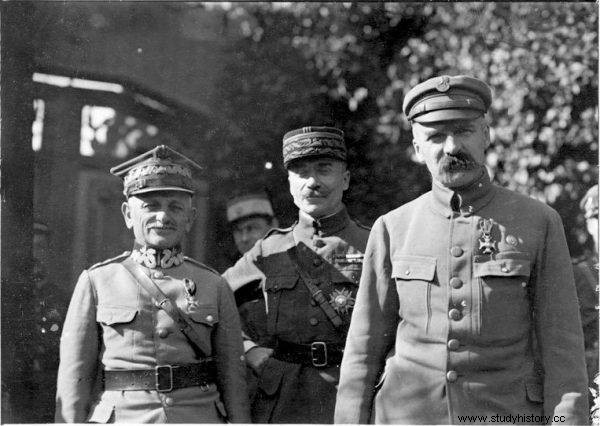
The Marshal, willing to personally intervene in military matters, officially spoke only a few times in aviation matters
Of course, this does not have to automatically mean reluctance, but it is puzzling that even Ludomil Rayski, who was the main apologist for Sanation among aviators, did not leave a dry thread on his military associates or on the army management system itself. And they were Piłsudski's people, and the system itself, with a division into the war and peace track, was to a large extent his original concept.
In addition, there is also the issue of personnel changes after the May coup, when everywhere possible, members of the so-called "legionary family" were placed, among which there were not too many airmen. As a result, almost on the eve of World War II, the air force commander was ... an infantry officer.
You describe vividly the figure of the air force commander Ludomil Rayski - was he a visionary?
Rayski was clearly a visionary. The problem was that his visions were quite far from the realities - especially the budget ones. At the same time, he was an extremely uncompromising character, which in the games at the junction of military and politics was hardly a feature that increased the effectiveness of his actions.
From the very beginning, he saw a force in aviation - even if not decisive - it certainly had a significant impact on the course of hostilities. He was also a supporter of developing bomber aviation that would operate on a strategic level. Only that the plans proposed by Rayski were too expensive for the military budget of the Second Polish Republic, even assuming that somehow the burden of financing could be shifted from "vegetative" expenses (pay for professional soldiers and officers, costs of maintaining barracks or symbolic hay for a horse) for modernization.
Perhaps Rayski had planned "in advance", knowing that ultimately these plans would be heavily cut anyway, but ultimately led to a situation in which his superiors began to treat him with a certain amount of indulgence.

You can read more about the history of Polish aviation in Łukasz Sojka's book "Skrzydlata husaria", which has just been published by the Znak Horyzont publishing house.
And what was his relationship with Piłsudski?
Rayski spoke about Piłsudski in superlatives until the end of his life, but he did not find much time for him, and their mutual relations never went beyond the formal framework.
The first planes of the Second Polish Republic were captured or "inherited" from the invaders, then machines from the Western Allies joined - since when can we talk about the beginnings of our own aviation industry?
Airplanes began to be assembled from captured parts as soon as the airports were seized, and it was basically the beginning of the Polish aviation industry. In these airport workshops, staff gaining experience in the assembly of proven machines was forged.
The first real aviation factory was the aviation production department established in 1920 in the Lublin mechanical plants of E. Plage and T. Laśkiewicz.
Why did the heavy bomber program fail in the early 1930s? Maybe Rayski's decision to put on his own industry was a mistake?
The very idea of expanding your own aviation industry was certainly not a mistake. Rather, it was just throwing him into deep water. Undoubtedly, we had very talented engineers, but designing and implementing the mass production of an aircraft is a multi-stage and complicated process.
The experience with the licensed construction of Italian Ansaldo aircraft has shown that the Polish industry is still in its infancy, although the shortcomings of the Italian construction were eagerly blamed. In fact, defective welds were responsible for the majority of fatalities involving the Ansaldo A.1 "Balilla" fighters manufactured in Lublin.
However, the Lublin "Balille" had the essential advantage that they were produced at all. The history of the Franco-Polish Aviation and Automobile Plant ended in a gigantic scandal, when after pumping several million Polish marks into this venture, the company left behind only unfinished buildings and several hulls.
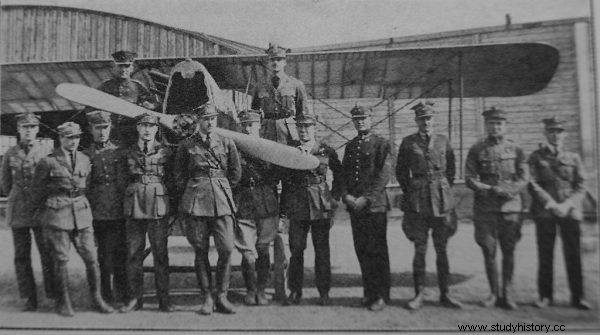
7th fighter squadron Tadeusz Kościuszko in September 1920 in Lviv, its commander was briefly Ludomił Rayski.
Rayski, taking over the aviation affairs after the May coup, decided to nationalize what he could, at the same time focusing on native structures. The apple of his eye was the State Aviation Works established on the basis of what was left of "Francopol" - and it was PZL that was to deal with the construction of most types of machines for the domestic aviation - liaison, fighter, bomb and communication.
It was then that the ambitious program to build the PZL.3 heavy bomber began, which ended in failure because, truth be told, it had to end in failure. For a machine like the PZL.3 - a great four-engine, comparable in size to the later "flying fortresses" - there was no room either in the defense budget or in Polish military doctrine. When planning the construction of this aircraft, Rayski apparently tried through the back door to implement his vision of strategic bomber aviation, but the scale of the project simply outweighed the young aviation industry.
In fact, why the Second Polish Republic had bombers at all, since - at least from 1934, when the idea of a preventive war with Germany fell through - no bombing of foreign cities was planned? Wasn't it better to focus on fighters that would defend Poland against enemy bombers?
Rayski assumed a relatively balanced development of various types of aviation, and at the PZL factories, work on the design of three basic machines for the army and a civil passenger plane was started at the same time. The fighter design materialized as the PZL P.1, which gave rise to a very successful series of aircraft. Its peak achievement was the exportation of PZL P.24 fighters.
Bombers, however, had no specific place in the official doctrine. They were, in a way, a remnant of the aviation development plans created by the "imported" from France by the pre-sanction authorities of General Francoise Leveque. There was a heavy bomber aviation that was supposed to operate at a strategic level. I think it was a kind of "deterrent force".
We must remember that Europe - especially Western Europe - emerged from World War I with two great traumas - the trauma of air raids on cities (even those far from the front) and the trauma of chemical warfare . Western military doctrines took it almost for granted to use bombers to attack cities with gas. In such a situation, one squadron of machines like the Farman Goliath could paralyze life in any capital, and if the raid came by surprise - massacre the inhabitants.
The possession of heavy bombers was therefore a kind of security policy, as it offered the possibility of retaliation. Especially since until the introduction of radars it was assumed that "a bomber will always break through".
The Poles (or even personally - Rayski) also had experience with the use of the captured Gotha G.IV heavy bomber during the Polish-Bolshevik war, where this machine rendered invaluable services in fighting enemy armored trains and destroying its railway infrastructure.
Probably everyone has heard about Łosi - medium bombers - but Poles also built Żubry and Karas. Were they successful machines? Żubr's fate was not too happy…
Żubr was a very problematic plane from the very beginning. It was created as a development of the passenger PZL.30 engineer Ciołkosz, the prototype of which was never finished. The very assumption to build an airplane according to a modern concept (monoplane with retractable landing gear) in proven, conservative technology was not bad - the English developed the excellent Hawker Hurricane fighter in this way, which was nothing else than a development of the Hawker Fury biplane - but Żubr was from the very beginning just a bad design.
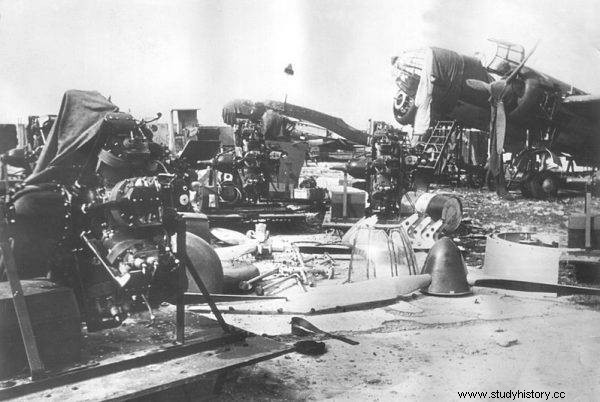
Polish PZL.37 Łoś planes captured by the Germans and disassembled.
The screw landing gear on the first prototype was so heavy and bulky that an electric mechanism was ordered for the second one from France. Its power consumption was so high that all other power receivers had to be turned off while the landing gear was being pulled in. And the chassis was just the tip of the iceberg. The main problem of Żubr was too much weight in relation to the engine power and structural strength.
And it was the insufficient strength of the wings that was most likely the cause of the disaster in which the Romanian delegation died, although the official reason was the opening of the door, which, hit by the propeller blade, damaged it, which in turn led to vibrations that ripped the engine out and destroyed the wing.
After the catastrophe, the wing structure was strengthened in all the built examples. Rayski stubbornly did not give up Żubr, seeing it as an ideal product for plants in Lublin, which he had earlier - to say the least - privatized by force. Żubr, which was first to be a competitor to "Łoś", then its "understudy" in the event of a modern project failure, and finally a training machine, became the most expensive bomber project in the Second Polish Republic. In 1939, attempts were still made to "slim down" and strengthen it so that it could be put into mass production.
The crucian carp was a successful and - what is important - mature construction. In 1939, most of the "childhood problems" were overcome in it. The trouble with Karas was that he was built as a liner - and that was a category transferred alive from the previous war. In the defensive war, it was used as a light bomber or reconnaissance machine - and in these roles it performed well, given the need to operate in conditions of total Luftwaffe domination.
The Romanians who took over the Karas, evacuated after September 17, 1939, used them successfully as long as spare parts were not exhausted - including at Stalingrad - which only confirms the value of these often underrated aircraft.
And how did Łoś rank in the ranking of machines of this class at the time - especially in confrontation with German bombers?
He was certainly at the forefront of this type of construction. We managed to build a fairly compact plane with a large load capacity and an amazingly high maximum speed. In 1939, it was able to take more bombs than any Luftwaffe medium bomber, but the use of field airfields forced the Elk crews to significantly reduce their combat load.
The elk had much weaker defensive armament - three machine guns compared to the 5-7 usually mounted on Luftwaffe bombers. However, the elk was a plane just entering the line - in practice, many modifications and improvements appeared only after the first year or even several years of service. The moose looked great, but what kind of plane it would be if its design had a chance to "mature" - we will never know.
What role did our medium bombers play in September 1939? You write that on September 1, Karas and Łosie "with suspended bombs and refueled tanks waited in vain for the order to take off", because the commander-in-chief had no idea how to use them.
The first hours of the war are actually decisive paralysis when it comes to using the Bomb Brigade. Despite the fact that the field airfields to which the planes were ferry were often unprepared or even unsuitable for bombers, brigade personnel brought all units to combat readiness.
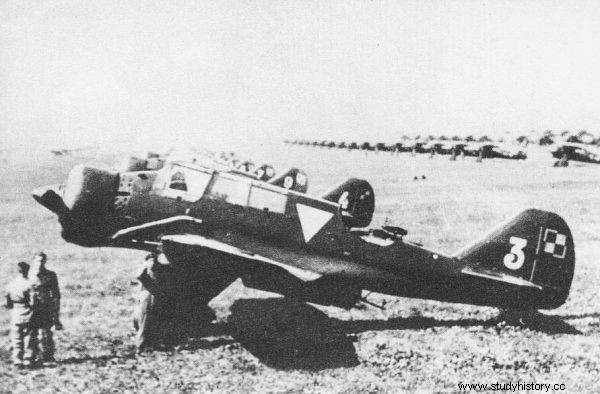
PZL.23A Karaś at the airport in Warsaw. In the background, PZL P.11 and PZL P.7 fighters lined up
Despite this, only reconnaissance flights were made, although it was in the first hours that well-aimed bombings could at least slightly weaken the impact of the armored headlamps of the Wehrmacht.
The problem was also that in August 1939, the crews of "Elk" were practicing bombing airports and railway junctions from medium altitude, and when the war broke out, the Commander-in-Chief did not have any data to set such targets for his bombing forces. Therefore, even before the start of operations, the assumptions for their use were completely changed, directing them primarily against enemy armored forces.
It seems that Marshal Śmigła on September 1 was not yet sure where the main attack was coming from, so he could not make a decision where to send his lean bombing force. As a result, most of the bombers spent the first day of the war at airports.
Neither Łosie nor Karasie were adapted to bombing the enemy's marching columns. The losses of the Bomb Brigade were quite high, and the effects of its activities were not very satisfactory. Where was the error?
It is true that neither Łosie nor Karasie were created with low-altitude attacks on armored columns in mind, but the decision to use them to strike the Wehrmacht headlamps was the only sensible option in September 1939.
Today, opinions are often expressed that the Bomb Brigade could have done more if it had been used to bomb junction stations, fuel tanks or supply warehouses, but in September 1939 the Polish staff did not have the intelligence to set such targets. Anyway, one has to say straightforwardly - in the Reich there were no such "panacea targets", the destruction of which would affect the course of the campaign . There were no single central fuel or ammunition depots.
The Luftwaffe operated from many dispersed field airports, and the density of the railway network in Germany and the former Prussian partition meant that each junction station could be bypassed without any problems. In addition, operations in the Reich would have to entail high losses (as confirmed by later Bomber Command RAF experiences), so the Bomb Brigade would probably cease to exist before anything could happen.
I am also not satisfied with the frequently repeated accusation that it was a mistake to incorporate Karasi into the Bomber Brigade - as light bombers they performed quite well as "retarders" of the armored blitzkrieg. We must remember at all times that the role of the Bomb Brigade was not to destroy as many tanks as possible, but to slow down the German advance through harassment. The success of the blitzkrieg was based on speed of action, and if this factor could be reduced, Polish troops would have a better chance of withdrawing in an orderly manner and taking up positions on the defensive perimeter along the lines of the great rivers.
Losses - especially those suffered by Karas - also did not result from such and no other choice of goals. Many mistakes were made, but before the war broke out. In my opinion, in September 1939 the bombers were used in the only rational way.
When assessing the context in which the Brigade operated, i.e. airports, supplies, etc., you use strong words:disgrace, scandal. Was it that bad?
Was. It is hard to call anything other than a disgrace and scandal when a formation with the most modern aviation equipment is sent on the eve of the war to the hub of airports, none of which are usable. This is what happened with the 10th and 15th squadrons, which were part of the Bomb Brigade, which were to be deployed at airports in the Lublin region.
The wheel-throw only came to convince the airports that the airports were not suitable for the Elk. The planes with the technical lead flew to Dęblin, and the wheeled throw joined them later. In this way, from the very beginning, the combat capabilities of the most valuable bomber units were severely limited.
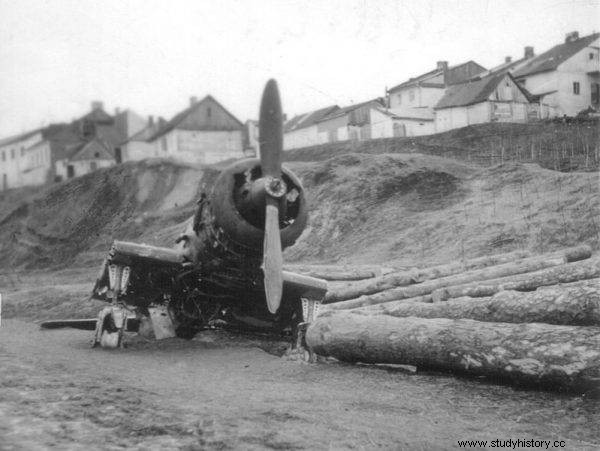
The crashed P-23B Karaś plane in Łęczna
Until the evacuation to Romania, the airmen of the Łosi and Karasi squadrons struggled with the shortages of airports prepared (or actually unprepared) by the military. There were "surprises" in the form of drainage ditches running across the take-off field, marshy terrain or the lack of any concealment. Squadrons lost not only invaluable time, but also machines in accidents that did not have to happen at all.
It would have been enough in August 1939 to send one competent officer in a plane like RWD-8, which was in abundance in the army and air clubs, to assess the sites planned for field airfields for bomber squadrons. It was not something that exceeded the organizational, equipment or budget capabilities of the Polish army. Such an audit was not carried out, however, and the bomber crews paid a high price for it.
And we didn't bomb Berlin either, as reported by the Polish press…
The Polish crews had to wait for a while to drop bombs on the capital of the Third Reich, but the time has come that the planes with the white and red checkerboard were regular "guests" over Berlin. It is difficult to say whether the press reports at that time were only the "joyful creativity" of journalists or the result of a planned propaganda campaign aimed at strengthening the will to resist and refreshing the fighting nation.
What is certain, however, is that the authorities of the Second Polish Republic conducted a consistent "propaganda of success", creating Poland as a local power. For example, before the visit of the Italian minister of foreign affairs, Count Galeazzo Ciano, all relatively complete Łosie were exhibited at Okęcie - including those that were in the local factory at various stages of assembly. Efficient machines were set up where the count was supposed to pass, those without equipment (and even engines!) Were placed in the distance to create the impression of a flotilla of several dozen bombers.
Our western allies were also convinced of the strength of the Polish army. In the issue of the English weekly "Flight", which appeared just before the outbreak of the war, the author writing about our aviation presents, among others, the PZL.38 Wilk as a basic heavy fighter, although it was an aircraft that existed only as a prototype.
The September reality brutally verified this superpower vision, although its echoes were still echoed in press articles, such as the one about Polish air raids on Berlin.
The bomber pilots also showed unnecessary bravery - breaking orders of commanders, unnecessary attacks, arbitrary bombing.
The desire to carry out the attacks "to the last round" was the main cause of the losses directly incurred in the attacks on the German marching columns. If we trace the reports from the bombing, we notice that Łosie and Karasie were not shot down during the first approach to the target, but rather in the next flights, when the crews fired machine gun columns. That this was unnecessary bravado was quickly realized by the commanders, forbidding the resumption of the raids after the bombs had been dropped, but many airmen "knew theirs" and did not intend to obey such orders.

You can read more about the history of Polish aviation in Łukasz Sojka's book "Skrzydlata husaria", which has just been published by the Znak Horyzont publishing house.
Perhaps it was an upbringing in the spirit of Sienkiewicz, which preferred heroism over rational thinking. What looked good on the pages of "Mr. Wołodyjowski" had fatal consequences in the realities of modern war. The losses inflicted on the Germans by the fire of three "Puppies" or Vickers mounted on each of the Polish bombers were marginal, and the Polish air force was losing priceless machines and crews as a result of such reckless actions.
Without this "heroism", the losses of the brigade could have been much smaller, and its impact on the course of hostilities much greater, the more so as the reports of Polish airmen often mention the theme of complete surprise of Wehrmacht soldiers during the first attacks and anti-aircraft artillery, which opened fire only during the second or third flight.
The end of the Second Polish Republic was not the end of the Łosiów epic - some of them went to Romania. What was wrong with them?
Elk and Karas were a tasty morsel for our recent allies, so the planes evacuated across the border were seized by the Romanian authorities on account of the contracts that had not been fulfilled by PZL. In Romanian aviation, both types were successfully used during the war with the Soviet Union, showing what they could achieve by fighting under adequate fighter cover.
They were withdrawn from the line only when they were grounded by the lack of spare parts, and after the end of the war, it was proposed to return the incomplete machines to Poland. Unfortunately, the authorities of the People's Republic of Poland ostentatiously decided that they did not need the Sanacja heritage and both Łosie and Karasie were cut into the proverbial razor blades.
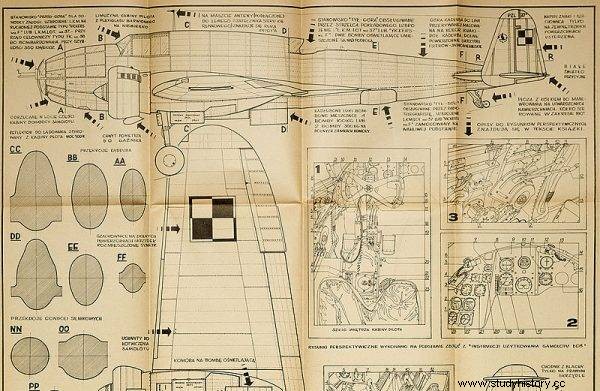
A fragment of a drawing of the PZL-37B Łoś plane by Andrzej A. Mroczek published in the Modelarz monthly (No. 9/1958) on the basis of which a life-size model of the Łoś was built at PZL-Mielec.
And they are nowhere to be seen anymore?
There are only artifacts from the shot down machines and the complete engine of the Elk, exhibited in the Krakow aviation museum. In the plant in Mielec, on the basis of modeling plans, a replica or - as the purists prefer - a "silhouette model" of the Elk in the scale 1:1 was made, which is a great tribute to this excellent aircraft, its crews and designers.
Your book is a story about wonderful people - designers and pilots - whose potential has been squandered by decision-makers. Or maybe there were objective reasons for the failure, such as the general weakness of Poland?
There was certainly no single cause of the tragedy that befell our country in 1939. There was also no one person personally responsible for her, although in émigré circles the search for "scapegoats" was launched with enthusiasm.
The "general weakness of Poland" is, however, a bit of a catch that we are trying to justify with the fact that we have been defeated. Let us remember that Germany emerged from World War I in a state of economic crisis, lost to Poland the fertile territories of Greater Poland and a large part of the Silesian industrial district, it was forced to pay gigantic contributions, and the Ruhr was occupied by the French for some time. Let's add the communist revolution of 1918 and we'll see that our western neighbor was not a land of milk and honey at all.
Unfortunately, the history of the Second Polish Republic is largely a history of wasted opportunities - and the fate of Polish bomber aviation is an excellent example of this. In 1919 and 1920, we were the pioneers of modern warfare - a war based on maneuver, technological advantage, which eliminates the numerical advantage of the enemy. However, both the Soviets, by implementing an unprecedented program of modernization and mechanization of the army, and the Germans drew conclusions from the Polish-Ukrainian and Polish-Bolshevik fights. Blitzkrieg, the victim of which Poland fell in 1939, was nothing more than a creative development of solutions implemented by people like Śmigły or Rayski twenty years earlier.
You can read more about the history of Polish bomber aviation in Łukasz Sojka's book "Skrzydlata husaria", which was published by the Znak Horyzont publishing house.
